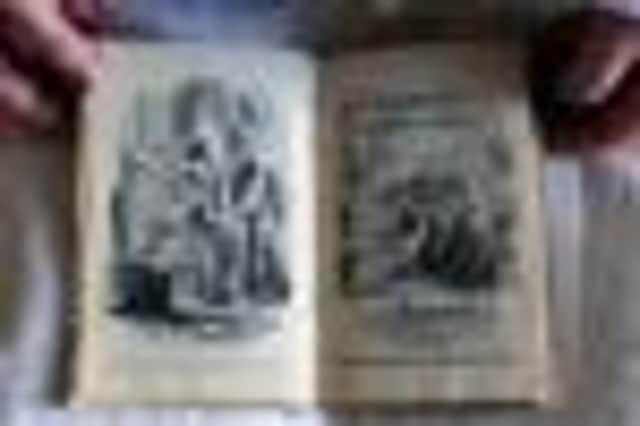Quartet who rivalled Jane Austen set to go online


Now, the world famous author’s forgotten “Scottish sisters” – Mary Brunton, Elizabeth Hamilton, Susan Ferrier and Catherine Sinclair – are to be introduced to a new generation of readers with a touch of tartan pride and prejudice.
The National Library of Scotland will next month host an event about the quartet who were as popular as Austen in their day, but whose reputations have not survived despite being serious rivals to the English author in the early 19th century.
Advertisement
Hide AdSome of their works are also being published online to a new audience of e-readers. Helen Vincent, senior curator at NLS, said: “Jane Austen was such a dominating figure that a lot of other novelists, particularly women, from that period have been forgotten.
“Meanwhile, Sir Walter Scott was such a dominating force that other Scottish writers of the time have also been forgotten. So if you were a Scottish writer of that era and a woman, you were doubly forced into the background.”
But, she added: “I think they are due for a resurgence. Many of their books are witty and funny and incredibly enoyable to read, as well as giving a Scottish perspective on the world Austen wrote about.”
Austen only achieved modest success in her lifetime. Yet her most famous novel, Pride And Prejudice, this year celebrates its 200th anniversary with over a dozen books about her hitting the shelves, as well as a US TV adaptation and a film which premiered at the Sundance Festival this month.
But when Austen first sold the book to her publisher in 1812 – a year before it was published – she was given only £110. In comparison Ferrier’s first novel, Marriage, a witty, and at first anonymous exposé of New Town Edinburgh society written in 1810, was sold for £150 and was such a success that, for the follow-up, The Inheritance, she was paid £1,500 – then an enormous sum.
“It shows you that her publisher clearly thought she was commerically very successful in order to offer that sort of money,” said Vincent. “She really was very popular.”
Advertisement
Hide AdBrunton, an Edinburgh-based author though born in Orkney, was writing in the same period as Austen and was viewed as more famous than her English rival. Indeed, in 1811 Austen wrote about being unable to get hold of a copy of Brunton’s first novel, Self-Control, such was its popularity, and worrying about the influence it might have on Pride And Prejudice, which she was then writing.
“We have tried to get Self-control, but in vain,” she wrote, and added: “[I] am always half afraid of finding a clever novel too clever–& of finding my own story & my own people all forestalled.”
Advertisement
Hide AdLaura Boyle, of the Jane Austen Centre in Bath said: “Austen had seen her own works, Sense And Sensibility, Pride And Prejudice, and Mansfield Park, published and was well on her way to enjoying their fruits of her own works. Brunton, on the other hand is known as ‘the forgotten Scottish novelist’ whose works rose very fast into celebrity but whose popularity seems to have as quickly sunk away.”
Vincent said one of the reasons the Scottish authors’ reputations did not survive was because their work was not championed after their deaths.
“There was nobody saying ‘look, this is a really great novelist, you should all read her novels’,” she said. “Austen’s reputation was eclipsed a little bit after her death but then in 1869 her nephew, James Edward Austen-Leigh, wrote a biography of her that propelled her back into the public eye. These other women, unfortunately, didn’t have anyone lobbying for them.”
The other two writers were also hugely popular during their lifetimes. Hamilton, born in Belfast but who returned to Scotland as a child, was so well-regarded that Sir Henry Raeburn painted her portrait (in contrast, the adult Austen never sat for a professional portrait), wrote a best–seller called The Cottagers Of Glenburnie, published in 1808, which was such a hit that a cheap edition was produced for working-class readers.
Meanwhile, Sinclair – born in 1800 and credited as being the person who discovered Sir Walter Scott’s authorship of the Waverley novels – found popularity in America in the 1840s and 1850s at a time when Austen’s writings had been almost forgotten. She was renowned as author of a book for children, the Holiday House, and works such as Modern Accomplishments, or the March of Intellect, a study of female education (1836).
The NLS has first editions of all four writers’ works, as well as examples of correspondence between Ferrier and her publisher, which details the vast sums of moneyshe was offered for her writings. Her first book, Marriage, has recently been republished by Virago Classics while Hamilton’s The Cottagers Of Glenburnie has been published by the Association for Scottish Literary Studies. Other works by all four are available free on e-reader Project Gutenberg.
Advertisement
Hide Ad“There was a time when you would have to come into the National Library to read these books because they hadn’t been reprinted in years, but it’s easier than ever to get hold of them now,” Vincent said.
Twitter: @emmacowing